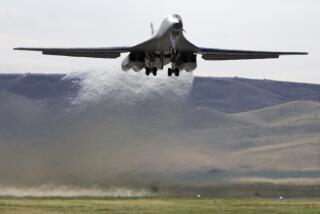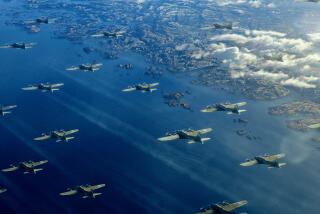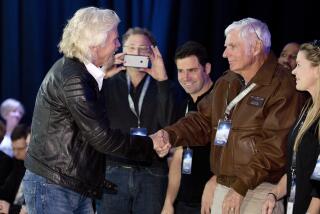Bomber Carries WWII Memories Across the U.S. : Aviation: The world’s only fully restored B-24 Liberator is visiting John Wayne Airport today and Saturday, open to public tour.
- Share via
SANTA ANA — It was the ugly duckling of the World War II bombers, always overshadowed by its more famous sisters.
But if the truth be known, according to those who flew it, the B-24 Liberator was the war’s workhorse. It could take punishment that the B-17 Flying Fortress and the B-29 Superfortress never could.
On Thursday, the only fully restored B-24 in the world flew into John Wayne Airport and rolled to a stop at Martin Aviation, where it will be on display today and Saturday.
The stop is part of a nationwide tour sponsored by the nonprofit Collings Foundation of Stow, Mass., which restored the bomber.
The 47-year-old bomber was originally scheduled to arrive here last weekend for the El Toro Air Show but blew an engine on its way from Tucson and was forced to land in Mesa, Ariz. It was the second major engine problem in as many weeks.
Co-pilot Craig McBurney lamented the delays and the cost of replacing an engine--$30,000 each.
“We owe $1.3 million for the cost of restoring the plane, and these unexpected costs don’t help,” he said. The $2,500 an hour it costs to fly the B-24 and the loans are paid by donations people pay to tour the bomber.
Former B-24 pilot Jay D. Coffman, 69, of Orange was there to meet the “All American” when it landed at John Wayne Airport. The last time he touched a Liberator was when he slid out the bomb bay door on June 25, 1944, over France. His plane had been hit first by antiaircraft fire and finished off by a swarm of German fighter planes.
Coffman, a Southern California Gas Co. manager before he retired, described flying the Liberator as a noisy and sometimes frigid experience that put thick calluses on his left hand and tired his mind and his body during the long hours of tight formations over France and Germany. To him it was the best plane in the world. The cockpit--although unpressurized and cold--included the latest technology of that day. More B-24s flew in World War II than any other bomber.
Stationed at an airfield somewhere between Ipswich and Norwich, England, in the spring of 1944, Coffman and his crew of eight flew 15 combat missions before and after the June 6, 1944, D-Day. On the 16th mission, his B-24 was hit by enemy fire, and Coffman bailed out at 14,000 feet. It was his first and last parachute jump, and he was captured and imprisoned for 10 months in Nazi POW camps.
Most of the 18,479 Liberators were scrapped after the war, while some found their way to the air forces of other countries. This B-24, nicknamed the All American after another B-24 that shot down 14 enemy fighters, was transferred to the Royal Air Force and finally to the Indian air force where it flew until 1968. In 1984, the plane was acquired by Robert F. Collings and restored.
Among the Liberator’s most spectacular wartime accomplishments, 177 of them from the 8th and 9th Air Forces left airfields in Libya in August, 1943, for a low-level attack on oil fields at Ploesti, Romania. Fifty-four B-24s were shot down on the mission, but they destroyed 40% of the refineries.
They also led the first bombing raid through flak-filled skies to open the decisive air battle over Berlin. One of their more famous crew members was former U.S. House Speaker Jim Wright of Texas, a bombardier.
“It may not have been as slinky and special looking as the B-17, but it served us faithfully and well,” Wright said.
The cramped quarters inside the 67-foot-long fuselage allowed little room for the 10-person crew. To get from the rear to the front of the plane, crew members had to walk along a narrow catwalk above the bomb bay doors, which could be open or closed. The belly gunner was put into a small capsule inside the rear cabin and hydraulically lowered into position outside the plane.
A gunner manning 50-caliber machine guns watched from open doors on either side of the plane while another crew member was stuffed into the tail turret. The bombardier and a gunner just above him were squeezed into the nose of the plane. Another gunner protected the top of the plane. The navigator, flight engineer, pilot and copilot made up the rest of the crew.
The noise inside the plane is deafening when the four 1,200-horsepower engines are running at or near full power. In the aft part of the craft a passenger can look through gaping holes in the floor where the belly turret fits loosely.
On a trip between Riverside and John Wayne Airport, the 48-year-old plane produced strange noises, shook, vibrated and rattled. The swimming pools of Anaheim Hills were visible through the floor.
The plane seemed to take off too slow and land too fast.
When it finally stopped, Coffman approached it slowly.
It wasn’t long before he was sitting in the pilot’s seat, peering out the window. It brought back war-time memories, some good and some bad.
“It looks pretty good,” he said to no one in particular. “Mine wasn’t this shiny. But then, I didn’t want them to see me.”
FACTS ABOUT THE LIBERATOR
B-24 Liberators led the first bombing raids over Berlin and flew waves of pre-dawn coastal attacks on D-Day. Although not as famous as the B-17 or the B-29, more B-24s flew in World War II than any other bomber. In one attack on German-held oil fields in Ploesti, Romania, 117 B-24s were sent on a 2,700-mile round trip from Libya. Fifty-four were lost on the sortie, but the bombers knocked out 40% of the refineries.
Dimensions: Wingspan 110 feet, length 67 feet, height 18 feet.
Engines: Four 1,200-horsepower Pratt & Whitney, 14-cylinder, two-row radials.
Builder: Consolidated-Vultee (Convair) of San Diego.
Numbers built: 18,479.
Crew: 10
Armament: Ten Browning machine guns arranged in four electrically operated turrets and two others operated manually.
Speed: 290 m.p.h.
Range: 3,000 miles.
Altitude: More than 28,000 feet.
Payload: 8,800 pounds of bombs.
Los Angeles Times
More to Read
Sign up for Essential California
The most important California stories and recommendations in your inbox every morning.
You may occasionally receive promotional content from the Los Angeles Times.










